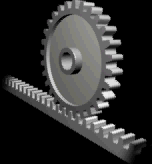
A pinion is a round gear—usually the smaller of two meshed gears—used in several applications, including drivetrain and rack and pinion systems.
Applications
Drivetrain
Drivetrains usually feature a gear known as the pinion, which may vary in different systems, including
- the typically smaller gear in a gear drive train (although in the first commercially successful steam locomotive—the Salamanca—the pinion was rather large). In many cases, such as remote controlled toys, the pinion is also the drive gear for a reduction in speed, since electric motors operate at higher speed and lower torque than desirable at the wheels. However the reverse is true in watches, where gear trains commence with a high-torque, low-speed spring and terminate in the fast-and-weak escapement.
- the smaller gear that drives in a 90-degree angle towards a crown gear in a differential drive.
- the small front sprocket on a chain driven motorcycle.
- the clutch bell gear when paired with a centrifugal clutch, in radio-controlled cars with an engine (e.g., nitro).
Rack and pinion

In rack and pinion systems, the pinion is the round gear that engages and moves along the linear rack.
See also
References
- Gear Nomenclature, Definition of Terms with Symbols. American Gear Manufacturers Association. 2005. p. 72. ISBN 1-55589-846-7. OCLC 65562739. ANSI/AGMA 1012-G05.
- Eric Perez. "Clutch Tuning". NitroRC.com. Retrieved 2010-01-29.
| Gears | |||||
|---|---|---|---|---|---|
| Systems | |||||
| Shapes | |||||
| Geartooth profiles | |||||
| Mechanics | |||||
| Examples |
| ||||
| See also | |||||
This engineering-related article is a stub. You can help Misplaced Pages by expanding it. |